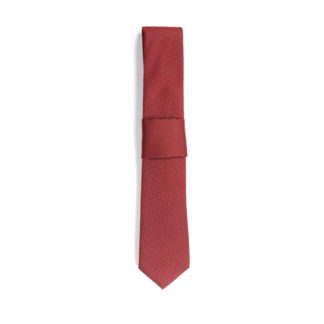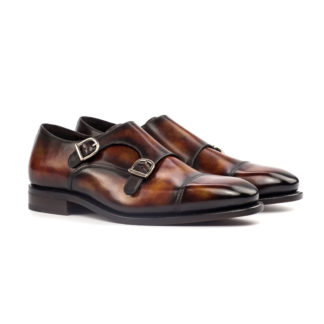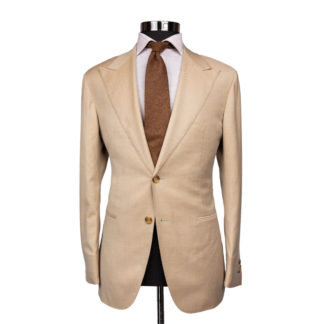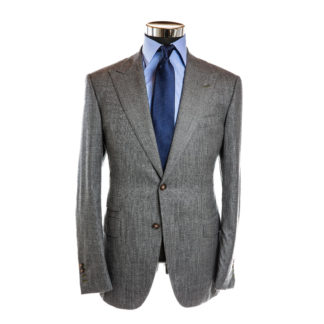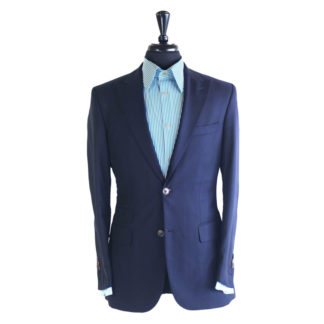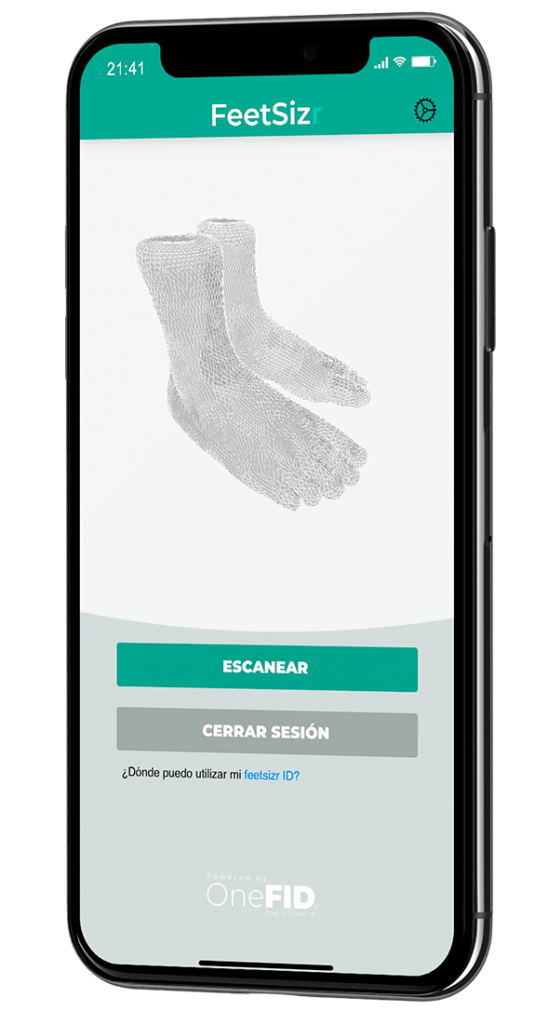
The Right Fit
Suits can be tricky: there are a lot of nuances in suit construction and fit that can make or break a look. No matter the dress code, the jacket, shirt, and trousers all have a variety of aspects that must work together for the suit to look well-fitted and neat. Today, we’re going to look at the different elements of a suit, and talk about how to determine if your pieces have a proper fit. If you are in need of a new suit immediately, check out our suit selection that we can customize to get the right fit for you. You can also read up on our guide to your first custom suit.
How to look for the right fit
First, when trying on your suit, you want to make sure you are standing in what is called the ‘natural stance’. In such a stance, you stand straight with your feet placed slightly apart and your arms hanging loosely by your sides.

The Right Fit: The Jacket
The jacket easily has the most elements that you need to consider when analyzing the fit of your suit. You must consider the space around the button, the collar, the sleeves, and the back panel, which includes the vents and length. The most important aspect of a jacket’s fit is the shoulders, because they act as the framework for the rest of the jacket and its drape over your body.
The Fit on The Shoulders
The shoulders should lie flat, with no ripples or lumps. Ripples or lumps are indicative of shoulders that are either too long or too short.
If the shoulders are too short, lumps appear because the edge of the suit shoulder pulls back over the the top of your actual shoulder. On the other hand, when the shoulders of a suit are too long, excess cloth hangs over the edge of your shoulder. The excess cloth forms lumps and ripples.
As a guide, wear shoulders that are slightly wider than your own shoulders. Doing so ensures there is room for the meeting between the shoulder and the arm to rest over the dress shirt without pulling taut.
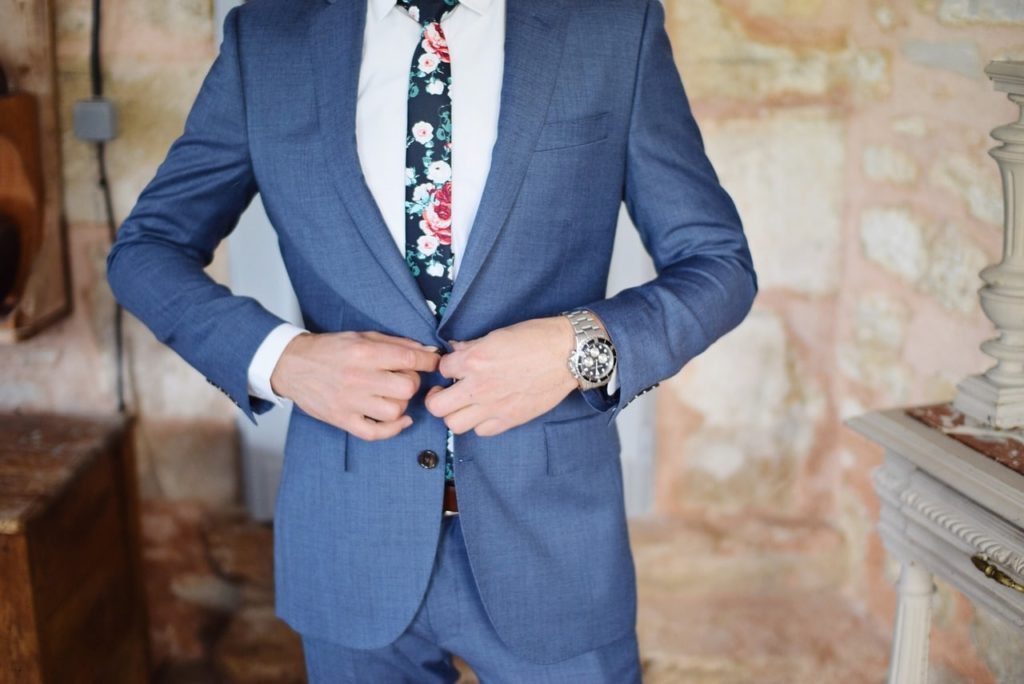
How Do The Buttons Fit?
Next, look at the buttons. If you’re in your ‘natural stance’, fasten at least one of the buttons. How does the jacket look when it’s stretched around your torso? If the lapels hang down and angle off your chest, the fit is too loose. If the jacket material pulls the button taut and the bottom corners of the jacket are flare outwards, it is too tight. As with the shoulders, you want no strain and no wrinkles.
The Collar Fit
Your collar is somewhat similar. If it’s too loose, it will hang back and won’t rest flat against your neck. If it’s too tight, it will bunch around the collar. You want it to rest against your neck and be closely fitted, but not too snug. You should be able to fit one or two fingers in between the collar and your neck itself. A poorly fitting collar could be because the size of the collar isn’t right for your body. Other reasons could be due to poorly fitted shoulders or an incorrect size for the back panel.
The Right Fit of the Back and Vents
Speaking of the back, the length should fall just along the curve of the buttocks. From the side view, the bottom hem of the jacket should sit right at the middle of the hand. The vents of the back panel should be sitting flat. That is, they should not pull outwards. If they do, then the fit is too tight. The sleeves come down to one thing: the amount of shirt cuff that is showing underneath the cuff of the jacket. You want there to be about half an inch of shirt cuff peeking out.

The Right Fit: The Shirt
The shirt is not quite as complicated as the jacket, even though it obviously contains many of the same elements that the jacket does. Much like the jacket, the collar should be snug, but there should be room for one or two fingers.
The Shoulder Fit
Compared to the jacket, the shoulders of the shirt should be an even closer fit. You don’t want any over-extension at the point where the shoulder meets the arm. Therefore, it should be as close a fit as possible without being tight. That’s because if the shirt is too tight, the shoulders will bunch up.
The Right Length
The shirt sleeves should end at the break of the wrist. You can identify the break as the point where the large wrist-bone is. Stylists recommend having about a half-inch of shirt cuff peeking out from underneath the jacket sleeve. The shape of the shirt should be slim against your torso with a natural taper near your waist. For shirt length, you want enough extra fabric to easily tuck the shirt in. Not only that, but there should be enough that if you lift your arms, it won’t untuck on its own. A good guide is that the extra fabric should reach the v-shaped panel at the top of the inseam.

The Right Fit: The Trousers
The Waist and Seat
The waist of your trousers should be snug, but not tight. They should stay up on their own without a belt. The seat should rest flat against the undergarments, without pulling tight or draping too loosely. If the seat is too tight, you will have lines just under the buttocks where the fabric is stretching. If it is too loose, the extra fabric will drape down over your thighs.
How Should Trouser Legs Fit?
The fit of the legs should be straight, with a very slight taper as the pant moves down the leg. They definitely should not flair out, but they also shouldn’t end up too tight around the ankle. That is, unless you want to look like a skater wearing skinny jeans. You want the legs to taper at a slight inward tilt, but still have room for movement. The ‘break’ – or the point where the hem of your pant meets the top of your shoe – is the most crucial part of a trouser fit. You want it to just rest on the top of your shoe. It should result in a slight inward dip right above the front of the pant leg. The break should hit right where the two elements meet.

The Elements Combined
When you put all of these together, a description of the right fit seems a bit redundant, but it’s the truth: you want everything to lie flat, for the majority of the elements. If your pieces are too tight or too loose, it will cause ripples, strains, and lumps that diminish the elegance you hoped to convey by wearing a suit in the first place. Now that we’re tying it all together, these things seem obvious, but we hope that the specific guidelines we’ve put forth here will help you look at all the elements individually, so that you are left with a perfect fit, every time.
Your Perfect Fit
Ready for your perfect fit? When we make our custom suits, we alter a pattern with your exact measurements. The pattern fits your body before we start constructing the suit, which produces a suit that’s a perfect fit. Even better, our H|M Mobile Tailor calculates your precise measurements down to a millimeter straight from home. All it takes is two photos from your smartphone camera.

